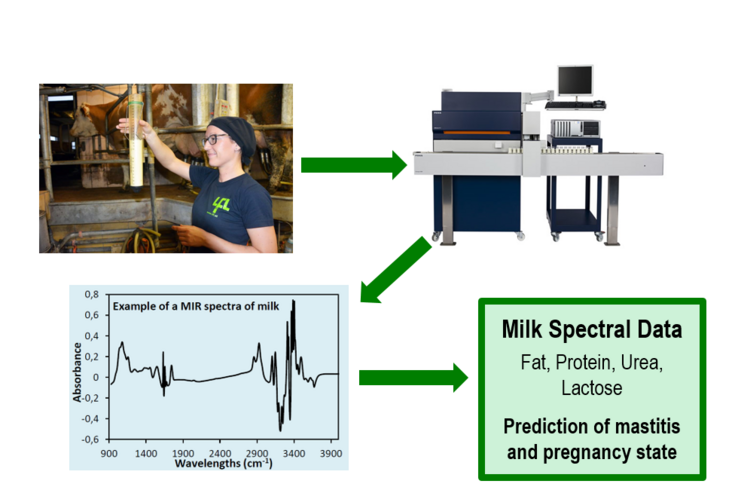Prediction of mastitis and pregnancy state from milk mid-infrared (MIR) spectroscopy in dairy cows and the genetic background of MIR predicted phenotypes
SUPERVISOR: Johann SÖLKNER
PROJECT ASSIGNED TO: Lisa Maria RIENESL
Mid-infrared (MIR) spectroscopy is the method of choice for the standard milk recording system, to determine milk components including fat, protein, lactose and urea. Besides, MIR spectra data could be used to predict other milk components. Because it is well known that the composition of milk is related to the health and metabolic status of the cow, its changes can be potential indicators for such conditions. In recent years, MIR spectra data have been used to predict various variables of interest, such as fatty acids of milk, feed intake, energy efficiency or ration composition. There are several studies on health traits and diseases, e.g. ketosis, mastitis and lameness.
The aim of this project is to predict mastitis and pregnancy state of cows from routinely recorded MIR spectral data from the Austrian milk recording system, to provide farmers with a management tool or to improve the genetic evaluation of the trait ‘Udder Health’. For developing a prediction equation for mastitis, diagnosis data recorded by veterinarians are linked to the MIR spectra of the closest dates of milk recording. Data from daily milk recording from the research station Raumberg-Gumpenstein will be used to validate and improve the prediction equations. For the prediction equation of pregnancy status calving and insemination data is used. The goal is to provide a probability of pregnancy status for every cow at every test day.
The heritability of MIR predicted mastitis probabilities and the genetic correlations with somatic cell score (SCS) and clinical mastitis diagnosis will be estimated. This is to evaluate whether the information can be used to improve the genetic evaluation of the trait ‘Udder health’. Genome Wide Association Studies on MIR predicted mastitis, SCS and clinical mastitis diagnosis will be performed, to get an insight in the genetic background of those traits.
This PhD project is carried out within the COMET-project D4Dairy, the overall goal of which is to provide digital support to dairy management by a data-driven, networked information system, exploiting the potential of advanced technologies and data analysis to further improve animal health, nutrition, animal welfare and product quality.

Figure 1 Procedure of MIR spectral data from routine milk recording
